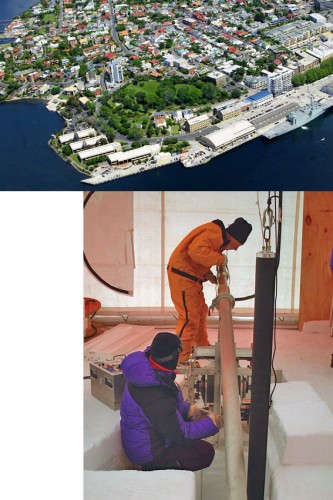Tasmania is punching above its weight in its contribution to the scientific study of climate change. [23 October 2007 | Peter Boyer]
Here we are at the bottom of Australia. At the bottom of the planet, even. Sticking out into the Southern Ocean, far from the symbols of civilisation. That’s Tasmania.

TOP CSIRO headquarters in the port of Hobart. BOTTOM Recovering a core of old ice from a deep drill on the Antarctic icecap
But today’s great climate debate is upending our perceptions of what’s important and what isn’t.
Once-obscure parts of the planet are starting to appear and re-appear in the news – places like Siberia, Greenland and the North-West Passage, West Antarctica and the Larsen Ice Shelf. And Tasmania.
In the developing global climate story the only significance of the northern hemisphere cities – our cultural icons – is in the high levels of greenhouse gases they produce. Otherwise they’re no more important than our own southern island.
Perhaps less so. Per head of population, Tasmania may have more people studying climate, and more climate research institutions, than any other comparable region on the planet.
Just as in the 1950s the pioneering climatologists Roger Revelle and Charles Keeling looked to remote Hawaii for data on rising global carbon dioxide levels, 15 years later Australia’s atmospheric scientists turned to Tasmania’s clear skies for vital southern hemisphere data.
Among many other things, the Cape Grim Baseline Air Pollution Station in Tasmania’s far North-West has verified and reinforced the story from Hawaii: that levels of greenhouse gases including carbon dioxide are steadily rising around the globe.
Cape Grim is operated jointly by CSIRO and the Bureau of Meteorology. CSIRO’s Division of Marine and Atmospheric Research, as well as the Bureau’s Antarctic and Southern Ocean weather forecasting program, have their headquarters in Hobart.
At Kingston is the headquarters of the Australian Antarctic Division, which coordinates a multi-million dollar research program in Antarctica and the Southern Ocean.
The University of Tasmania has a strong interest in large-scale climate programs centred on Hobart’s Institute for Antarctic and Southern Ocean Studies.
All these strands come together at the University-based Antarctic Climate and Ecosystems Cooperative Research Centre – supported by all the major players in Tasmania’s climate science story.
Operating from bases in Antarctica and aboard the ocean research ships Aurora Australis and Southern Surveyor, and using remote-sensing systems yielding year-round data from the ocean around Australia and the ice to our south, Tasmania’s climate scientists can reach far into the world’s remotest places.
Like everyone, scientists appreciate a community of peers. A combination of good luck and good management has built such a community in Tasmania. It richly deserves our recognition and continuing support.
